|

by Tom Worden
29 September 2011
from
DailyMail Website
Spanish version
108 square mile island is home to 10,000 people
More than 8,000 tremors have been recorded on island in the last two
months
Last eruption on El Hierro was in 1793 and lasted a month
Residents put on standby for emergency evacuation over fears of
landslides
A holiday island popular with Britons is
preparing for a mass evacuation because of a possible volcanic
eruption.
Experts have recorded 150 tremors on
El Hierro, the smallest of the
Canary Islands, since yesterday - raising fears of an imminent
eruption. Last night 53 people were ordered out of their homes over
fears of landslides and the army has been called in to prepare for a
possible evacuation.
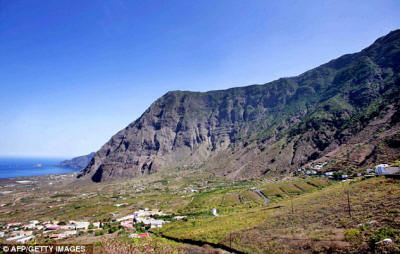
About to blow?
Parts of the Canary
Island of El Hierro have been evacuated over fears of a volcanic
eruption
Schools on the tiny island, home to
10,000 people, have been closed and a tunnel linking the two main
towns - Frontera and Valverde - has been shut.
Volcano expert Juan Carlos Carrecedo said:
"There is a ball of magma rising to
the surface producing a series of ruptures which generate
seismic activity. We don't know if that ball of magma will break
through the crust and cause an eruption. But he warned an
eruption was possible 'in days, weeks or months'."
The last volcanic eruption in the Canary
Islands took place on the island of La Palma in 1971.
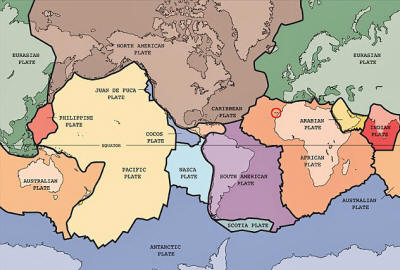
Tectonic plates map
with the Canary Islands circled.
The last volcanic
eruption in the Canary Islands took place on the island of La Palma
in 1971
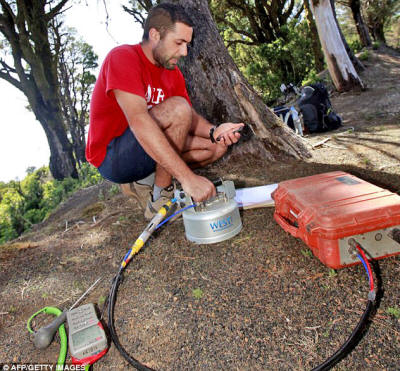
Readings: A
seismologist records the seismic activity on the island.
There are fears the
tremors could cause landslides
El Hierro, which has an area of just 108
square miles, is popular with British tourists looking for quiet
sunshine holidays away from the bustle of neighbouring islands like
Tenerife and Lanzarote.
It is not known how many, if any, Britons are currently on the
island.
More than 8,000 tremors have been registered on El Hierro since July
19, collectively known as an earthquake 'swarm'. Only 15 of them
have been strong enough for people on the island to notice, but
yesterday an earthquake of 3.8 on the Richter scale was felt all
over the island.
The last eruption on El Hierro, which has around 250 small volcanic
craters, was in 1793 and lasted for a month.
Newspaper
Canarias7.es reported that two units of the Spanish
military's emergency intervention unit will leave Tenerife today to
help with any evacuation operation.
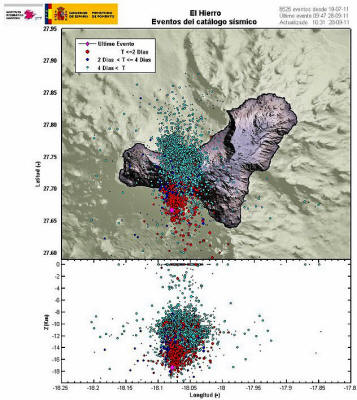
Eruption: A diagram
showing where the epicentres of tremors have been.
El Hierro was formed
when three volcanoes erupted 100 million years ago
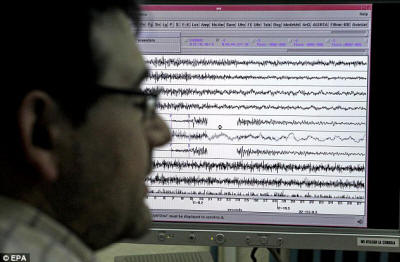
Warning: Seismic activity is shown on a monitoring screen.
Experts say a ball of
magma is rising up underneath El Hierro, and could trigger a
volcanic eruption
The Canary Island government began a
geological survey of El Hierro earlier this month to determine what
was causing the tremors.
It raised the volcanic risk to 'yellow' on Sunday - the highest
alert status since the earthquake 'swarm' began in July. Some
experts said a volcanic explosion could actually attract more
tourists to the island.
Eumenio Ancochea, volcanologist at Madrid's Complutense
University, said:
'An eruption could fill the island
with people interested in these phenomenon. It's normal that
people are scared but there is no danger. After an eruption the
lava advances at a few meters per hour and you can easily take
photographs as it descends.'
SO IS EL HIERRO ABOUT TO EXPLODE?
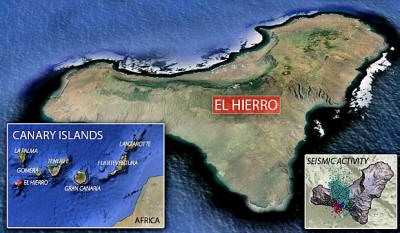
Magma: El Hierro is
the smallest of the Canary Islands,
but has more than 250
small volcanic craters
Under the Canary Islands lies an area of
magma which is able to break through to the surface when the African
Plate - on which the islands sit - shifts. It is to this that the
islands owe their very existence.
Most of the islands are still volcanically active and there has been
speculation that a smaller, previously undetected fault line also
runs through the chain.
El Hierro - which means 'iron' in Spanish - was formed after three
volcanic eruptions 100 million years ago and is topped by a volcano
more than 6,000ft high. Volcanic activity - mainly where three ridge
lines converge - has caused El Hierro to expand continually. The
last time it erupted was in 1793.
Some 50,000 years ago, massive landslides triggered by earthquakes
caused a large part of the island to crack off and fall into the
Atlantic Ocean, according to Irish Weather Online. That created the
El Golfo valley on the island and caused an 300ft-high tsunami that
probably reached the American coast.
This feeds into the belief that volcanic activity on La Palma - the
most tectonically active of the Canary Islands - could trigger a
mega-tsunami. The theory - which has never been confirmed - claims
that a possible fault line through the island would cause a major
landslide under certain circumstances.
That landslide would then spark a tsunami that would cause extensive
damage all down,
|






